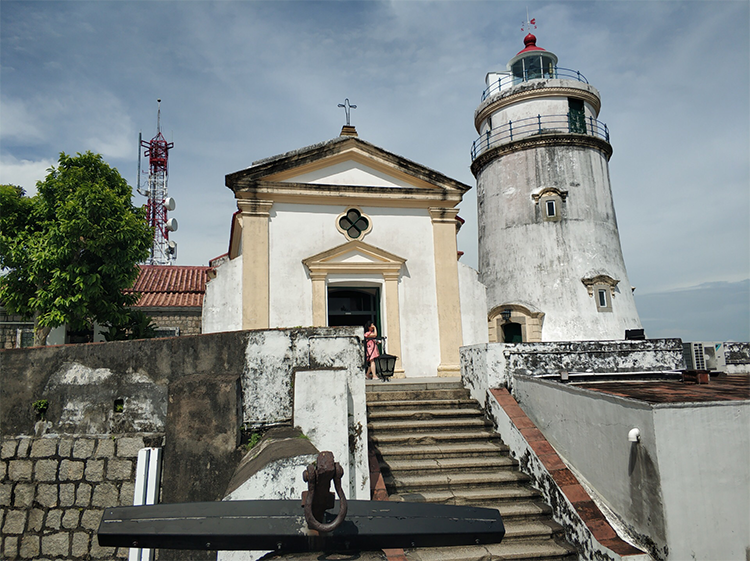Guia Fortress & Lighthouse: Visitor Guide to Macau’s Heritage Peak
Intro:
Perched 93 meters above sea level, the white Guia Lighthouse and yellow fortress walls carve Macau’s most iconic skyline against the blue. This site is both a panoramic lookout over the peninsula and Pearl River mouth and a compact history book: from 17th-century Portuguese defenses to China’s first modern lighthouse and a hidden Baroque mural chapel. When the lighthouse still guides ships at night, the UNESCO site quietly recounts Macau’s centuries-long maritime saga.
1. Four centuries of fortifications: fan-shaped defenses and the Chapel of Our Lady of the Snow
Built in 1622 to deter Dutch invasion, the Guia Fortress uses a fan-shaped defensive layout at the hill’s summit. Thick coral-stone walls and seaward gun positions preserve the integrity of 17th-century military engineering. At the fortress’ center, the Chapel of Our Lady of the Snow is a hidden gem: a compact building modeled on Roman basilicas that shelters rare Baroque-style murals. The angels in these paintings carry a softness influenced by East Asian brushwork — a vivid example of East-meets-West artistic exchange. Look down at the chapel floor and you can still see the herringbone stone blocks soldiers chiseled to prevent slipping.

2. The country’s first modern lighthouse: a 15-meter maritime landmark
Completed in 1865, the Guia Lighthouse stands 15 meters tall and rewrote China’s navigational history. Equipped with the era’s most advanced optics, its beam once reached 20 nautical miles. Architecturally it is a Portuguese-style gem: pure white walls with pale-yellow window trims, and a spiraling iron staircase that feels like a passage through time. The lighthouse remains an active aid to navigation; its beam sweeps the harbor every 10 seconds, a living salute to the age of exploration. Limited interior access allows visitors to climb to the lantern room for a 360° panorama — from modern casino towers to the red-tiled roofs of the old city.

3. Macau’s last remnant of original woodland: an urban ecological refuge
Surprisingly, the UNESCO compound includes the peninsula’s only well-preserved native woodland. Follow the circular mountain trail to discover native species such as Diospyros (local ebony relatives) and coastal shrubs rustling in the breeze; migrating birds stop here in autumn and winter. The area is free from heavy commercial development, and you’ll spot butterflies slipping through fortification crevices. Early morning visits reward photographers: mist, the lighthouse, and ancient trees form an ink-wash-like landscape.

4. Practical guide: how to unlock the best experience
– Getting there: From Senado Square (Largo do Senado) take buses 6B or 28B to the “Guia Incline (Dongwangyang Xiexian)” stop, then a 15-minute uphill walk; or hike about 20 minutes up the trail behind the Grand Lisboa hotel.
– Best times: Aim for sunrise or two hours before sunset to avoid tour groups and capture dramatic light (site closes at 18:00 in summer, 17:30 in winter).
– Cultural extras: On Wednesday afternoons the Chapel of Our Lady of the Snow offers guided talks explaining the chapel murals and Sino-Western symbols (Cantonese/Portuguese) — email in advance to reserve a spot.
– Tickets: Entry is free with the Macau World Heritage pass (which covers 12 sites including the Ruins of St. Paul). Single-entry tickets cost MOP 15.

5. Nearby pairings and things to do after your visit
– Feng Tang Alley (Feng Tang Xié Xiàng): A 10-minute walk brings you to a Portuguese-style creative lane featuring converted century-old houses with rotating exhibitions on Macanese culture.
– Tap Seac Square: Visit on a Sunday for the Portuguese-themed market and pick up hand-painted tile replicas featuring the lighthouse.
Closing note:
Every stone on Guia Hill breathes history. When you trace the coral-stone walls and feel the lighthouse beam, you connect with sailors, soldiers, and artists across four centuries. Here there are no casino lights — just the tactile, layered truth of Macau preserved in stone and light. Next time the lighthouse sweeps its beam, will you be the traveler it shines upon?


